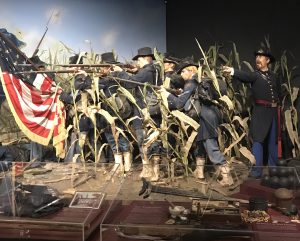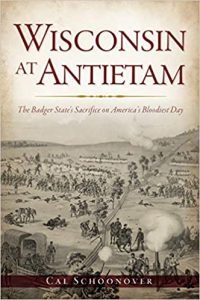Death at Antietam: Friends to the End
ECW welcomes back guest author Cal Schoonover…
The Civil War impacted Wisconsin’s people from the beginning of the war until the end on April 9, 1865. Wisconsin had no shortage of volunteers during the early part of the war; however, like several other states, the urge dwindled as the war continued. The men who fought for the Badger state had many reasons to join. One was for the adventure, with another to make the country whole again. Some even joined to further their political careers.
President Abraham Lincoln called upon the nation, asking people to volunteer to preserve the Union. Wisconsin’s Republican Governor, Alexander Randall rounded up not just the one regiment that the Lincoln administration asked for but several. Three of the regiments formed what became known as the Iron Brigade, consisting of the 2nd Wisconsin, the 6th Wisconsin, the 7th Wisconsin, and the 19th Indiana. By the end of 1862, the 24th Michigan became part of the brigade as well.[1]
By the war’s end, Wisconsin provided more than 91,000 soldiers to 56 different regiments. Of the 91,000, over 77,000 alone fought in the infantry, with over 8,000 assigned to the cavalry and around 5,000 to the artillery.[2]
The excitement and pro-war rallies did not last long, however, in the Badger State. After the loss at First Bull Run, the disorganization of the Northern army showed. In Wisconsin, residents became less enthusiastic about the war and became irate when states instituted a militia draft. Riots broke out in the cities of Port Washington, West Bend, and Milwaukee.
For two Wisconsin men, the enthusiasm and excitement of what could be had been too much to risk passing by. 19-year-old Franklin Gerlaugh and his long-time friend, William P. Black, also 19, enlisted on May 10, 1861, and were assigned to the 6th Wisconsin, Company A., The 6th Wisconsin was organized on July 16, 1861, at Camp Randall, in Madison, Wisconsin. As a regiment of the Iron Brigade, the 6th suffered severe losses at the Battle of Antietam. Twenty-nine men were killed, with over 100 wounded.[3]
Gerlaugh and Black were born in 1843 in Freedom, WI. They attended the same school, and their families attended the same Westfield German Methodist Church that still stands to this day. The 6th Wisconsin spent a year in Washington, D.C., where they were drilled daily. Gerlaugh and Black were anxious to see battle. Their wish was finally granted at Gainesville, VA, and the Second Battle of Bull Run starting August 28 through August 30, 1862 both men coming through uninjured.[4]
General John Pope’s loss at Second Manassas raised concerns for the Lincoln Administration and the people of Washington. The defense of Washington had been a priority, with panic setting in with the city’s citizens. Not far from the White House, a gunboat sat at the ready on the Potomac, giving some people the impression President Lincoln may leave Washington if Confederate forces lay siege to the city.[5]
On September 2, the Army of the Potomac faced another change in command; President Lincoln reinstated Major General George B. McClellan to lead the army. Over the next few days, McClellan reorganized his army and sent marching orders. The First Corps, under the leadership of Major General Joseph Hooker, along with the Ninth Corps under Major General Jesse L. Reno, were to form the right-wing of McClellan’s army. Their orders were to march north to prevent General Lee from attacking Baltimore, while the remaining parts of the army moved northwest toward Frederick.
After several days marching, the Army of the Potomac finally met up again with Lee’s Army of Northern Virginia. The Battle of South Mountain occurred on September 14, and the Iron Brigade made a stand at Turner’s Gap. The next morning, September 15, the First Corps, including the Iron Brigade, marched through Boonsboro, then “veered to the left and followed the road toward Sharpsburg.”[6]
Franklin and Gerlaugh, along with their brothers in arms, were exhausted and enjoyed the downtime. Some soldiers wrote letters, played cards, or just wanted the rest. Early the next morning, the Army of the Potomac found themselves on the move again. The First Corps would move all day until arriving in position north of the town of Sharpsburg.
After taking position on the Joseph Poffenberger Farm on September 16, the First Corps settled in for the night. It would not be restful; the sounds of sporadic rifle fire kept many soldiers on edge throughout the night. By dawn, General Gibbon received orders to send his Iron Brigade into action. Once orders were issued, the Iron Brigade went into formation and moved south through the North Woods. Confederate artillery began almost the instant Gibbon’s men began moving toward the small, whitewashed building known as the Dunker Church.[7]
Not knowing where the main Confederate line was, Gibbon sent two companies forward to act as skirmishers. The rest of the 6th Wisconsin followed close behind, along with the rest of the brigade. Once they reached the main road, the Hagerstown Pike, they were to move south. Coming under heavy fire from the 31st Georgia, the 6th Wisconsin skirmishers halted and exchanged small arms fire for several minutes before forcing the Georgians to pull back.

To prevent the Confederates from flanking, Gibbon ordered the 7th Wisconsin and the 19th Indiana to break away, move to the right and approach the West Woods from the north. The 6th Wisconsin, its right-wing moving slowly south along the Hagerstown Pike, and the left going through standing corn at a slow, but steady pace. Within a few hundred feet came the David R. Miller’s barn just where the road began to rise. The 6th Wisconsin skirmishers did not encounter Confederate Captain A.C. Page’s 21st Virginia skirmishers who were lying in wait behind haystacks near the barn.[8]
Page’s skirmishers wasted no time and opened fire on the unsuspecting right wing of the 6th Wisconsin. Having little time to react, Gerlaugh and Black, like many of their other soldiers had no time to defend themselves. The first deadly round of Page’s skirmisher’s gunfire found its mark. One bullet struck Gerlaugh through the forehead, going clean through. Seeing his friend begin to fall, Private William Black reached for his friend. As he did this, a bullet tore through Black’s throat, killing him instantly. After the battle, fellow Union soldiers found the two men on where they went down; Black’s head rested on his dear friend’s body.[9]
In the aftermath of the Battle of Antietam, both Franklin Gerlaugh and William P. Black were wrapped in a blanket and buried in the same grave at Antietam’s cemetery. Within a year of the battle, Gerlaugh’s father made the journey from Wisconsin to the bloody battlefield, where his son and his best friend made the ultimate sacrifice. The plan was to recover the men’s bodies and bring them home to bury them. Upon locating the grave, Gerlaugh’s father dug the men up. He discovered transporting the bodies back to Wisconsin had become impossible due to the bodies decomposing and intertwining together.
To this day, both Franklin Gerlaugh and William P. Black remain at Antietam’s soldier’s cemetery in the same grave. Gerlaugh’s father requested a headstone placed at the grave with both men’s names on it. The two best friends grew up together, joined the army together, and made the ultimate sacrifice seconds apart with both spending eternity together in the same grave. They both died heroes. On Wisconsin!
Cal Schoonover is the author of the book Wisconsin at Antietam: The Badger State’s Sacrifice on America’s Bloodiest Day, published by the History Press, October 2020. Cal holds a B.A. in 18th and 19th Century Military History and a M.A. in Military History. He is currently pursuing a PhD in American History. Cal resides in Wisconsin with his son, James.
[1] Cal J. Schoonover, Wisconsin at Antietam: The Badger State’s Sacrifice on America’s Bloodiest Day, (The History Press, October 2020), 9-11.
[2] https://www.wisconsinhistory.org/Records/Article/CS3355 (accessed 01/11/2021).|[3] Ibid
[4] Bob Dewel, baraboopubliclibrary.org/files/local/dewelvol4/12civilwarcentenniarecallslocalsoldiers.pdf (accessed 01/11/2021).
[5] Ezra A. Carman, Thomas G. Clemens (Editor), The Maryland Campaign: September 1862. Volume 1, 130-31.
[6] Schoonover, Wisconsin at Antietam, 66.
[7] Ibid, 72.
[8] Ibid, 76-77.
[9] Schoonover, Wisconsin at Antietam, 77.

Thanks for this moving story. The post discusses sporadic rifle fire on the evening of September 16. Only recently did I learn that the two Armies fought on the afternoon od September 16 near the East Woods. For years I thought of Antietam as a one day battle on the 17 th, not appreciating that Hooker’s Corps was on the field on the 16th and engaged Confederates in some sharp fighting.
Excellent article!